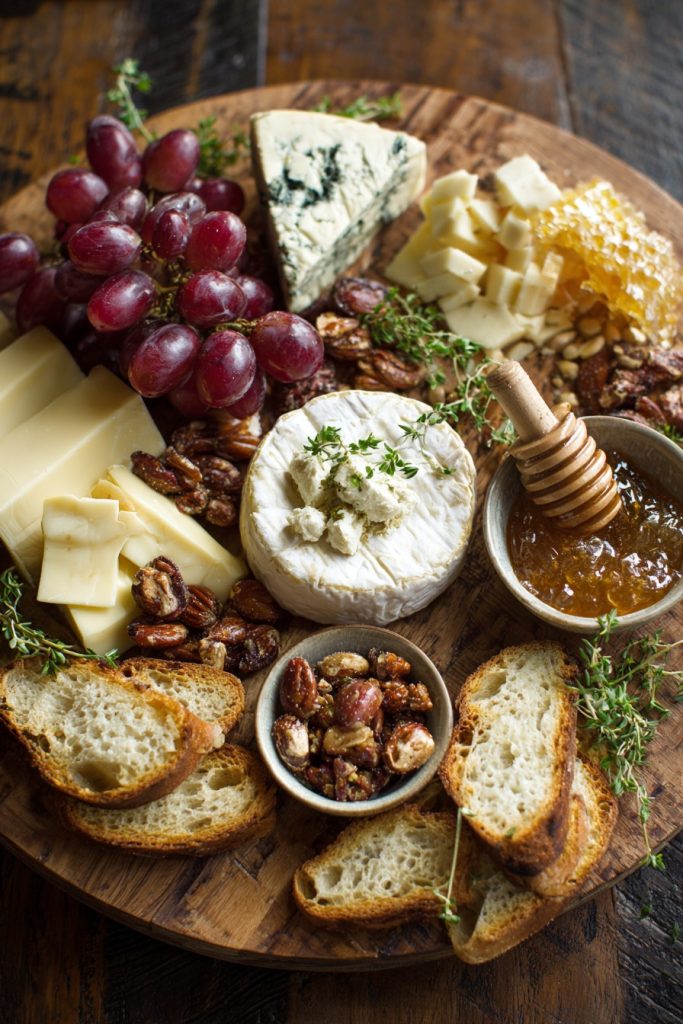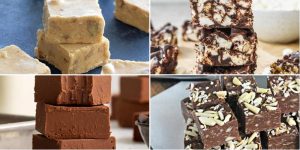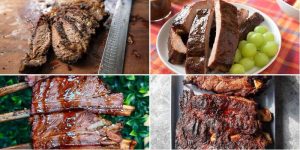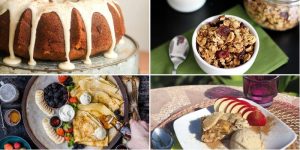Zestfully curated cheese boards transform ordinary gatherings into memorable culinary experiences through thoughtful composition and technique-driven assembly. Mastering the art of cheese plate construction requires understanding flavor progression, textural balance, and visual presentation principles that elevate simple ingredients into sophisticated arrangements. This professional approach ensures each component harmonizes while maintaining individual integrity across the tasting journey.
Why This Recipe Works
- The strategic progression from mild to robust cheeses allows palates to gradually acclimate to increasing intensity, preventing flavor fatigue while showcasing each cheese’s unique characteristics through calculated sequencing that respects both the dairy’s complexity and the taster’s sensory experience.
- Incorporating multiple textural elements—from creamy brie to crystalline aged gouda—creates dynamic mouthfeel variations that engage different sensory receptors, transforming a simple tasting into a multidimensional experience where contrast becomes as important as flavor compatibility.
- Thoughtful accompaniment selection based on complementary and contrasting principles ensures each element enhances rather than overwhelms the cheeses, with sweet preserves cutting through fatty richness and acidic components cleansing the palate between different dairy varieties.
- Strategic spacing and grouping techniques prevent flavor cross-contamination while creating visual appeal, allowing guests to intuitively understand the intended tasting progression through deliberate arrangement that guides both eye and palate.
- Temperature management through proper cheese tempering before serving unlocks full aromatic potential and ideal texture, as chilled cheeses suppress volatile compounds while properly warmed varieties express their complete flavor profile and desired mouthfeel characteristics.
Ingredients
- 4 ounces triple cream brie cheese, brought to room temperature
- 4 ounces aged manchego cheese, thinly sliced
- 4 ounces blue cheese wedge, such as Roquefort or Gorgonzola
- 4 ounces sharp white cheddar, cut into 1/2-inch cubes
- 1/2 cup marcona almonds, lightly toasted
- 1/4 cup honeycomb, broken into small pieces
- 1/2 cup fig preserves
- 1/4 cup cornichons, drained and patted dry
- 1 baguette, sliced into 1/4-inch thick rounds
- 2 tablespoons extra virgin olive oil
- 1/2 teaspoon flaky sea salt
- 1 bunch red grapes, washed and dried
- Fresh thyme sprigs for garnish
Equipment Needed
- Large wooden cutting board or slate serving platter
- Cheese knives (spreader, fork-tipped, and hard cheese knife)
- Small ramekins or bowls for condiments
- Parchment paper
- Sharp chef’s knife
- Cutting board
- Small baking sheet
- Pastry brush
Instructions

Prepare and Temper Your Cheese Selection
Remove all cheeses from refrigeration approximately 60-90 minutes before assembly to achieve ideal serving temperature between 65-70°F. This critical tempering process allows volatile aromatic compounds to fully express themselves while ensuring optimal texture development—creamy cheeses should feel supple but not oily, while firm varieties should yield slightly to pressure without cracking. Arrange cheeses on a clean cutting board, spacing them to allow air circulation while they come to temperature. Monitor environmental conditions carefully, as excessive warmth can cause fat separation in high-butterfat varieties like triple cream brie. During this resting period, evaluate each cheese’s condition: check for desired bloom on soft-rind varieties, assess crystallization in aged specimens, and note any oil separation that might indicate overheating. Proper tempering transforms chilled, muted cheeses into their most expressive forms, revealing nuanced flavors and textures that would otherwise remain dormant.
Toast and Season Your Bread Components
Preheat your oven to 375°F and arrange baguette slices in a single layer on a parchment-lined baking sheet. Using a pastry brush, lightly coat each slice with extra virgin olive oil, ensuring even coverage while avoiding saturation that would lead to greasy texture. Sprinkle with flaky sea salt, focusing on even distribution rather than heavy application. Bake for 8-10 minutes until edges turn golden brown and centers remain slightly chewy—watch carefully during the final minutes as thickness variations can cause uneven browning. Remove from oven when approximately 70% of slices show visible color development, as carryover cooking will complete the process. The goal is achieving structural integrity that supports cheese weight without shattering, while maintaining enough flexibility for easy handling. Cool completely on a wire rack to prevent steaming, which would compromise the desired crisp texture. Properly toasted crostini provide neutral yet flavorful foundations that complement rather than compete with cheese profiles.
Arrange Cheese with Strategic Placement
Begin assembly by placing your largest cheese (typically the brie) at the 6 o’clock position on your board, creating a visual anchor. Position manchego at 10 o’clock, white cheddar at 2 o’clock, and blue cheese at 8 o’clock—this diamond formation establishes clear tasting stations while allowing natural movement around the board. Leave substantial space between varieties to prevent flavor transfer and provide adequate cutting access. Place cheese knives according to type: spreader near soft cheeses, fork-tipped by crumbly varieties, and hard cheese knife adjacent to aged specimens. Ensure each cheese maintains its intended form—wedge the blue cheese dramatically, cube the cheddar for easy grabbing, fan the manchego slices, and present the brie whole with a small cut to indicate it’s ready for serving. This thoughtful arrangement creates intuitive navigation while showcasing each cheese’s unique visual characteristics.
Professional Tip: Always place stronger cheeses downwind from milder varieties to prevent aromatic dominance.
Incorporate Complementary Accompaniments
Strategically place small ramekins containing fig preserves and honeycomb at board intersections where they can service multiple cheese varieties. Scatter marcona almonds in small clusters near firm cheeses where their crunch provides textural contrast, while arranging cornichons in linear formations that create visual lines leading toward acidic-loving cheeses like cheddar. Drape grape clusters artfully in open spaces, using their organic shapes to soften geometric cheese placements. The honeycomb should be positioned near blue cheeses where its floral sweetness balances pungent notes, while fig preserves belong near triple cream brie where their fruit acidity cuts through rich butterfat. Create intentional negative space between accompaniment groups to prevent visual clutter while allowing each element to shine independently. This calculated distribution ensures every cheese has appropriate partners within reach while maintaining overall compositional balance.
Professional Tip: Use odd-numbered grouping for visual appeal—clusters of three or five create more dynamic arrangements.
Execute Final Garnishes and Temperature Check
Complete your composition by tucking fresh thyme sprigs between cheese wedges and accompaniment clusters, using the herb’s woody stems to create elevation variations that add dimensional interest. Lightly drizzle remaining olive oil over aged cheeses to enhance their glossy appearance and amplify flavor release. Conduct a final temperature assessment by gently pressing each cheese with your clean fingertip—soft varieties should yield without resistance, firm cheeses should feel cool but not cold, and blue cheeses should exhibit slight tackiness indicating proper oil migration. Adjust room placement if necessary, moving the board away from direct sunlight or heat sources that could compromise texture. Verify that all serving tools are positioned correctly and that adequate space exists around each element for comfortable guest interaction. This final quality control ensures optimal tasting conditions from first impression to last bite.
Professional Tip: Garnishes should enhance rather than obscure—use them to fill visual gaps without covering key components.
Tips and Tricks
For exceptional cheese plate execution, consider these advanced techniques that transcend basic assembly. When selecting cheeses, aim for diversity across milk types—incorporating cow, goat, and sheep’s milk varieties creates inherent complexity that delights experienced palates. Within cow’s milk cheeses, include examples from different aging categories: a fresh triple cream, semi-soft washed rind, firm aged specimen, and blue-veined variety establishes comprehensive tasting progression. Always purchase cheeses in wedge form rather than pre-sliced or crumbled, as exposed surfaces dry out and lose volatile aromatics—the exception being specifically designed crumbled varieties for salads or cooking applications.
Master the art of cheese cutting to preserve integrity and presentation. Soft cheeses like brie should be served whole with a small starter cut to indicate serving direction, while wedges of blue cheese maintain dramatic presentation when cut to show veining patterns. Hard cheeses benefit from thin slicing against the grain to highlight crystallization, and crumbly varieties should be pre-broken into serving-sized portions to prevent messy board fragmentation. Invest in quality cheese knives—a soft cheese spreader with perforations to prevent sticking, a fork-tipped knife for crumbly varieties, and a hard cheese knife with pointed tip for breaking into aged specimens.
Temperature management deserves particular attention beyond basic tempering. During extended service, monitor cheese conditions and rotate pieces if necessary—softer cheeses may need brief refrigeration if the environment exceeds 72°F, while harder varieties can typically withstand room temperature longer. For outdoor events, use chilled marble slabs beneath your board to maintain cooler temperatures, or employ small ice packs strategically hidden beneath garnish elements. Understand that cheese continues to evolve at room temperature—blue cheeses become more pungent, soft cheeses more unctuous, and aged varieties more crystalline as they warm.
Accompaniment selection should follow seasonal availability and regional pairing principles. Spring boards might feature fresh strawberries and young almonds, while autumn arrangements highlight dried fruits and roasted nuts. Consider cultural pairing traditions—Spanish cheeses naturally complement membrillo and marcona almonds, while French varieties pair beautifully with Dijon mustard and cornichons. For unexpected sophistication, incorporate one unconventional element like dark chocolate-covered espresso beans with blue cheese or spicy honey with aged gouda. Always include one purely acidic component like pickled vegetables to cleanse palates between rich cheeses.
Presentation techniques significantly impact perceived quality. Use board materials that complement your cheeses—slate provides dramatic contrast for light-colored cheeses, while wood offers warmth and traditional appeal. Create height variation using small inverted bowls hidden beneath cheese wedges or clustered accompaniments. Employ the rule of thirds for visual balance, grouping elements in triangular formations rather than linear arrangements. For large format boards, create multiple tasting stations that allow different group sizes to gather without congestion. Finally, remember that cheese plates continue to evolve throughout service—replenish bread and accompaniments as needed, and don’t hesitate to rearrange elements as they diminish to maintain visual appeal.
Recipe Variations
- Mediterranean-Inspired Board: Replace traditional selections with feta cheese marinated in olive oil and herbs, kasseri for slicing, and halloumi for grilling. Incorporate kalamata olives, roasted red peppers, pepperoncini, and dolmas alongside pita triangles and tzatziki. The briny, acidic profile of Mediterranean cheeses pairs exceptionally with the region’s characteristic flavors, creating a transportive tasting experience that highlights different preservation techniques and milk treatments.
- American Artisanal Selection: Showcase domestic cheesemaking excellence with a cloth-bound cheddar from Vermont, triple cream from California’s Point Reyes, and blues from Oregon’s Rogue Creamery. Accompany with local honey, candied pecans, and apple butter that reflect regional terroir. This variation celebrates American cheesemaking renaissance while educating guests about distinctive styles emerging from different microclimates and dairy traditions across the United States.
- Vegetarian Charcuterie Alternative: Create depth without meat products using smoked gouda for umami notes, mushroom pâté for savory richness, and marinated tofu cubes for protein variety. Add roasted vegetables like blistered shishito peppers and confit garlic, plus seeded crackers for textural interest. This approach demonstrates how plant-based boards can achieve complexity through clever ingredient selection and preparation techniques that mimic traditional charcuterie elements.
- Dessert Cheese Board:
- How far in advance can I assemble a cheese plate? Optimal assembly should occur 30-60 minutes before serving to maintain ideal texture and temperature balance. While you can prepare components separately several hours ahead—toasting bread, washing fruits, and portioning condiments—final cheese arrangement benefits from last-minute execution. Cheeses left assembled for extended periods may experience undesirable texture changes as oils separate and surfaces dry. If advance preparation is necessary, cover loosely with parchment paper and refrigerate, then bring to room temperature for 45 minutes before serving. Remember that cut surfaces oxidize and lose freshness, so keep cheeses whole until the final hour. The exception is very hard cheeses like Parmigiano-Reggiano, which can be pre-cut without significant quality loss.
- What’s the proper way to store leftover cheese? Proper storage begins with separating cheeses by type and rewrapping in fresh materials. Soft cheeses prefer wax or parchment paper that allows breathing, while hard cheeses benefit from tight plastic wrap to prevent drying. Blue cheeses require separate airtight containers to prevent mold transfer. Always label cheeses with purchase dates and bring to room temperature before re-serving. For best results, consume leftovers within 3-5 days, though very hard aged cheeses can last several weeks. Never freeze cheese as ice crystal formation destroys texture and flavor compounds. If cheese develops surface mold on hard varieties, simply trim 1/4 inch beyond the affected area and continue use.
- How do I calculate quantities for different group sizes? Plan for 2-3 ounces of total cheese per person as a starter, increasing to 4-5 ounces for main course portions. For accompaniments, allocate approximately 1/4 cup nuts, 3-4 bread slices, 2 tablespoons preserves, and 1/4 cup fruit per guest. These ratios ensure balanced tasting while preventing waste. For large groups, include more cheese varieties rather than larger quantities of fewer types—diversity creates interest and accommodates different preferences. Remember that richer boards with multiple accompaniments require less cheese per person, while minimalist presentations need larger cheese portions. Always err toward slightly more bread and crackers, as these inexpensive fillers help balance rich cheeses.
- What are the best wine pairings for mixed cheese boards? Versatile wines that complement multiple cheese types work best for diverse boards. Crisp Sauvignon Blanc cuts through rich cheeses while complementing goat varieties, while medium-bodied Pinot Noir bridges the gap between delicate and robust cheeses without overwhelming any. For blue cheese dominance, opt for sweet counterparts like Sauternes or Port that balance pungency. Sparkling wines like Champagne or Prosecco provide cleansing bubbles that refresh the palate between different cheeses. When in doubt, choose regional pairings—Italian cheeses with Italian wines, French cheeses with French wines—as these combinations have evolved together over centuries. Always offer both white and red options to accommodate different preferences and cheese selections.
- How can I accommodate dietary restrictions on a cheese board? Create designated zones for different dietary needs while maintaining visual cohesion. For lactose intolerance, include aged hard cheeses like Parmigiano-Reggiano and aged gouda that contain minimal lactose. Vegan guests appreciate nut-based cheeses, marinated vegetables, and abundant fruit selections. Gl-free crackers and bread should be grouped separately with dedicated serving utensils to prevent cross-contamination. Label components clearly and arrange boards with logical flow that allows guests to easily identify appropriate options. Consider preparing small individual boards for severe allergies while maintaining the communal spirit through coordinated presentation and shared accompaniments that everyone can enjoy safely.
Summary
Mastering cheese plate construction requires technical precision in temperature management, strategic flavor progression, and artistic presentation. Through careful selection of diverse textures and complementary accompaniments, you transform simple ingredients into sophisticated culinary experiences that engage all senses while showcasing cheese at its optimal expression.



